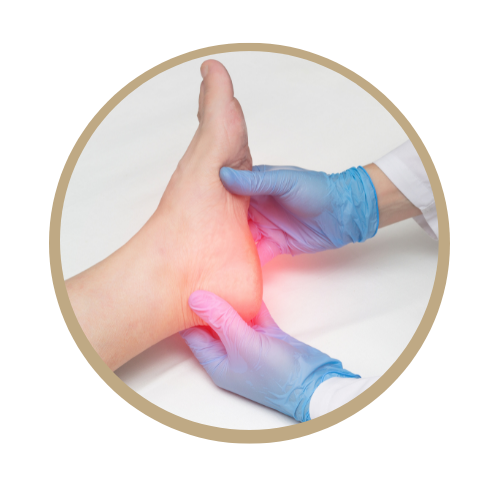Ancaster Foot Fixer and Orthotics Clinic
Plantar Fasciitis / Achilles Tendonitis
Plantar Fasciitis / Achilles Tendonitis
Plantar fasciitis is a common condition that involves inflammation of the plantar fascia, a thick band of tissue that runs along the bottom of the foot, connecting the heel bone to the toes. The plantar fascia acts as a shock absorber and supports the arch of the foot. When this tissue becomes inflamed, it can lead to heel pain and discomfort, particularly in the morning or after periods of rest. Here's an explanation of what plantar fasciitis is and its common causes:
Causes of Plantar Fasciitis:
-
Strain and Overuse: One of the primary causes of plantar fasciitis is the repetitive strain and overuse of the plantar fascia. This can result from activities that involve prolonged standing, walking, running, or other high-impact activities that put stress on the feet.
-
Foot Mechanics: Abnormal foot mechanics, such as flat feet (pronation) or high arches (supination), can contribute to the development of plantar fasciitis. These conditions alter the distribution of weight on the feet, leading to increased stress on the plantar fascia.
-
Tightness in the Achilles Tendon: Tightness or shortening of the Achilles tendon, the tendon connecting the calf muscles to the heel, can contribute to plantar fasciitis. When the Achilles tendon is tight, it limits ankle movement and places additional stress on the plantar fascia.
-
Obesity or Weight Gain: Excess body weight can put additional strain on the plantar fascia, increasing the risk of inflammation and heel pain.
-
Improper Footwear: Wearing shoes with inadequate support or improper arch support can contribute to plantar fasciitis. High heels and shoes with inadequate cushioning may also be factors.
-
Age: Plantar fasciitis is more common in individuals between the ages of 40 and 60, possibly due to the natural aging process, changes in foot structure, and decreased flexibility.
-
Occupational Factors: Jobs that require long hours of standing or walking on hard surfaces may increase the risk of developing plantar fasciitis.
-
Muscle Imbalances: Weakness or imbalances in the muscles of the foot and calf can contribute to altered biomechanics and increased strain on the plantar fascia.
Common Symptoms of Plantar Fasciitis:
-
Heel Pain: The primary symptom is pain at the bottom of the heel, typically near the front of the heel pad.
-
Pain in the Morning: Pain is often most severe with the first steps in the morning or after periods of inactivity, gradually improving with movement.
-
Pain with Activity: Pain may increase during activities that put stress on the plantar fascia, such as walking, running, or standing for extended periods.
-
Tenderness: The affected area may be tender to the touch.
Achilles Tendonitis
Achilles tendonitis is a condition characterized by inflammation of the Achilles tendon, which is the large tendon that connects the calf muscles to the heel bone. This tendon is crucial for activities like walking, running, and jumping, and when it becomes inflamed, it can cause pain and discomfort. Here's an explanation of what Achilles tendonitis is and its common causes:
What is Achilles Tendonitis? Achilles tendonitis is the inflammation of the Achilles tendon, typically resulting from overuse or repetitive stress on the tendon. It's a common condition that can range from mild discomfort to severe pain.
Causes of Achilles Tendonitis:
-
Overuse and Repetitive Stress: One of the primary causes is repetitive stress on the Achilles tendon, often due to activities that involve a lot of running or jumping. This overuse can lead to microtears in the tendon, triggering inflammation.
-
Tight or Stiff Calf Muscles: Lack of flexibility in the calf muscles can increase the strain on the Achilles tendon during movement, making it more susceptible to inflammation.
-
Sudden Increase in Physical Activity: A rapid and significant increase in the intensity or duration of physical activity, especially in activities that heavily involve the Achilles tendon, can contribute to tendonitis.
-
Improper Footwear: Shoes with inadequate support or those that don't properly cushion the heel can contribute to the development of Achilles tendonitis.
-
Poor Biomechanics: Abnormal foot mechanics, such as overpronation (excessive inward rolling of the foot) or flat feet, can put additional stress on the Achilles tendon.
-
Age: As individuals age, the blood supply to the tendons decreases, making them more prone to injury and slower to heal. Achilles tendonitis is more common in middle-aged individuals.
-
Previous Injuries or Conditions: Previous injuries to the Achilles tendon or conditions like tendinopathy can increase the risk of developing tendonitis.
-
Certain Sports and Activities: Sports that involve repetitive jumping or sudden stops and starts, such as basketball or tennis, can increase the risk of Achilles tendonitis.
Common Symptoms:
-
Pain and Stiffness: Pain along the back of the heel or just above it, particularly after physical activity.
-
Swelling: The affected area may be swollen and warm to the touch.
-
Tenderness: Tenderness to touch around the Achilles tendon.
-
Limited Range of Motion: Difficulty flexing the foot or standing on tiptoes.


